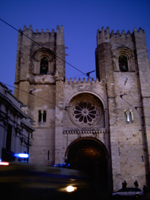 The
Panteão Nacional was built on the request of the Princess
D Maria (1521/1577,) the daughter of King D Manuel, who was
a well known patron of the arts during the early 16th Century.
The
Panteão Nacional was built on the request of the Princess
D Maria (1521/1577,) the daughter of King D Manuel, who was
a well known patron of the arts during the early 16th Century.
A new parish created by letter of Pope Pius V in 1568 was to be served by this new church. Work on the single-nave church began in 1570 after a drawing by the architect Jerórnimo de Rouen.
In 1630, a tabernacle was desecrated in the Church. A New Christian by the name of Simon Solis was wrongly accused of the crime although on the night of the crime he had been courting a nun at the nearby Convent of St Clare. The following year, he was burned. In 1632, the Brotherhood of the Slaves of the Holy Sacrement decided to build a new chancel to atone for the profanity. Mateus do Couto directed the works for the Chancel which began right away but a shortage of funds and the War of Restoration which finished in 1668 prolonged the completion of the chancel.
After the War of Restoration a new plan was commissioned from João Antunes who was a relative unknown at the time. The Panteão Nacional would, ultimately, make the name of the former apprentice to Paço da Ribeira from whome he learnt the rudiments of architectural drawings. João Antunes would go on to be appointed Royal Architect in 1699.
 The
Panteão Nacional is built in the Baroque-style of
architecture in the shape of a Greek Cross - ie a cross with
four-equal arms - with undulating walls and topped with a
cupola.
The
Panteão Nacional is built in the Baroque-style of
architecture in the shape of a Greek Cross - ie a cross with
four-equal arms - with undulating walls and topped with a
cupola.
After the death of João Antunes in 1712, doubts about the structures ability to support the cupola were raised.
The Ministry of Public Works, through the Directorate-General of National Buildings and Munments, has proposed completing the building. Historians Damião Peres and Mário Chicó and architect Raúl Lino have found a solution for the design of the cupola. The designs have proved controversial. Raúl Lino has prooposed two towers along the façade of and a simpler cupola based on traditional Portugese architecture.
The building was classified as a national Monument by Decree on the 16th June 1910. The Church of Santa Engrácia was chosen as the National Pantheon be Decree on the 19th April 1916.
The Panteão Nacional now houses the tombs of Teófilo Braga, Sidónio Pais and Óscar Carmona, Presidents of the Republic, the writers João de Deus, Almeida Garrett and Guerra Junqueiro and Marshal Humberto Delgado.
Cenotaphs at The Panteão Nacional are those of Luís de Camões, Nuno Ávares Pereira, Alfonso de Albuquerque, Vasco da Gama, Pedro Álvares Cabral and Prince Henry the Navigator.
Primary source: Pamphlet available at the church
Map
View Larger Map
Misc Information
Opening hours
- Tuesday to Sunday 10am to 5pm
- Closed on Mondays and, January 1st, Goood Friday, Easter Sunday, 1st May and 25th December
How to get there
Bus routes: 9, 25, 35, 39, 46, 81, 90, 104, 105 and 107
Trams: no 28 Prazeres/Estrela
Parking
In Campo de Santa Clara







